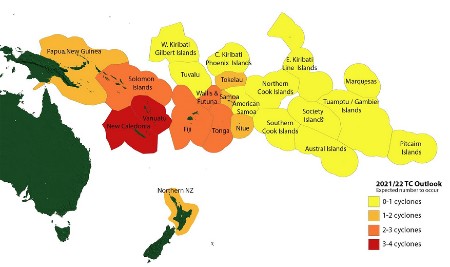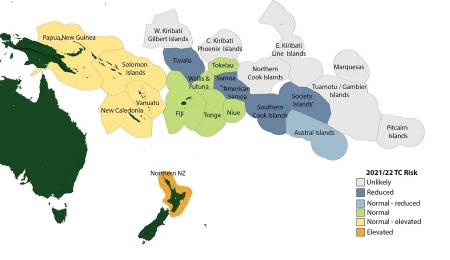Pacific: Cyclone Season Preview for 2021/2022
The 2021/2022 Pacific Cyclone Season officially began on November 1 and forecasters are predicting between nine and 12 tropical storms, with three potentially reaching Tropical Cyclone Category 3 or above.
Published 4 years ago
Tropical Cyclones (TC) have a significant impact across the Southwest Pacific. New Zealand’s National Institute of Water and Atmospheric Research (NIWA) says for the coming season, important differences are expected between the western and eastern halves of the Southwest Pacific basin and also for early and late season activity.


- NIWA’s Tropical Cyclone Outlook for the South Pacific for 2021/2022.
Elevated TC presence is expected in and around the Coral Sea, especially during the late season between February and April. The risk of a TC interaction is expected to be higher across the maritime regions around the Coral Sea and in the subtropics between Fiji and New Caledonia. Reduced TC activity is expected east of the International Date Line.
- Nine to 12 tropical phenomena could be named between the Australia’s Queensland coast and Polynesia
- Three of them at least could reach category 3 or above (tropical cyclone)
- Possibility of higher cyclonic activity at sea of coral and reduced in eastern Fiji.
- Normal cyclonic activity raised for Papua New Guinea, Solomon Islands, Vanuatu and New Caledonia (3 to 4 tropical depressions and possible cyclones in our waters this season)
- New Zealand could be impacted by several systems during their south or southeast evacuations.
- A risk of depressionary activity at the beginning of the season (November / January) that would lie in Vanuatu and New Caledonia (4) and would be higher in the southern Solomon Islands at the end of the season (February / April) as well as at the Australian coast and between Vanuatu and Fiji (5).


- NIWA’s Risk Assessment for the 2021/2022 South Pacific Cyclone Season.
Fiji Met Service Offers Slightly Different Forecast
The Fiji Meterological Service Forecast is slightly different to the NIWA forecast, predicting a normal or slightly below normal number of tropical cyclones in the region.
- This season’s TC outlook is greatly driven by the likelihood of a development of La Nina event towards the end of 2021.
- One to three total number of cyclones are likely to pass through Fiji’s Exclusive Economic Zone during the 2021-22 tropical cyclone season.
- One to two cyclones are likely to reach severe category (Category 3-5) during the season.
- Most of the past cyclones during La Nina TC seasons have approached the Fiji Group from the west. Therefore, there will be elevated risks for the Western Division this season.
- With the likelihood of a La Nina event during the TC season, there is increasing chances of flooding across the Fiji Group, during November to April.
- The peak tropical cyclone season in the RMSC-Nadi TCC Area of Responsibility (from the equator to latitude 25 south – between longitude 160 east and 120 west) is usually between January to March.
- While the TC season is between November to April, occasionally cyclones have formed in the region in October and May and rarely in September and June. Therefore, an out of season tropical cyclone activity cannot be ruled out.
- Tropical disturbances or depressions that do not attain TC intensity or low-pressure systems that are remnants of older cyclones, can still cause widespread rainfall and potential flooding.
In La Nina years slow moving tropical depressions forming close to Fiji bringing prolonged heavy rain are relatively common, and are typically responsible for most major flood events in recent decades. In all tropical cyclones and tropical depressions, the most common cause of death is drowning, either in swollen rivers or coastal inundation by sea water.
Major flood events cause restrictions in movement when roads are cut, bridges and smaller river crossings are damaged or destroyed, and heavy seas will restrict maritime activity. Disease is the next most common cause of death, with wind typically having a relatively minor impact on human injury or death.
Australia’s Bureau of Meterology Forecasts Near Average Number of Tropical Cyclones
In the 2021/2022 Tropical Cyclone Outlook, the Bureau’s Senior Climatologist Greg Browning said that the increased likelihood of La Niña in the tropical Pacific Ocean has influenced this year’s tropical cyclone outlook.
Even if La Niña doesn’t develop, some La Niña-like effects can still occur as tropical Pacific climate indicators approach La Niña thresholds.
- Above-average number of tropical cyclones are expected in the western South Pacific region this season (based on 59% probability), with a high level of accuracy.
- Near-average tropical cyclone numbers are also likely for the eastern South Pacific but model accuracy is very low.
- Queensland could experience an average, or slightly above average, number of tropical cyclones this season, with an increased risk of widespread flooding.
- On average, the Coral Sea would see four tropical cyclones in a season, and during 2021-22 we are expecting an average to slightly above average number.
…………………………………………………………………………………………………………………………………………
Related Links:
Australia: BOM Tropical Cyclone Outlook 2021/2022
Australia: BOM South Pacific Outlook 2021/2022
New Zealand: NIWA – Southwest Pacific Tropical Cyclone Outlook 2021/2022
New Zealand: NIWA – Seasonal Climate Outlook
Fiji: Port Denarau Marina Cyclone Procedures
Fiji: Port Denarau Marina Cyclone Holes
………………………………………………………………………………………………………………………………………….
Noonsite has not independently verified this information.
Related to following destinations: Australia, Cook Islands, Federated States of Micronesia, Fiji, French Polynesia, Kiribati, Marshall Islands, Nauru, New Caledonia, New Zealand, Niue, Samoa, Solomon Islands, Tokelau, Tonga, Tuvalu, Vanuatu, Wallis and Futuna, Western Samoa
Related to the following Cruising Resources: Hurricanes and Tropical Cyclones, Pacific Crossing, Pacific Ocean East, Pacific Ocean South, Pacific Ocean West, Routing, Weather







